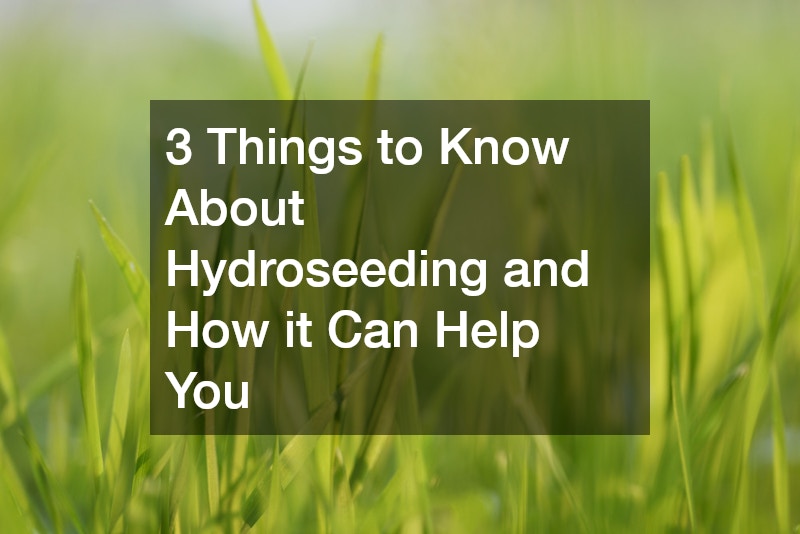We will explore the concept of hydroseeding, a popular method for establishing grass and plant cover, especially in areas that need quick revegetation. This technique is not only efficient but also cost-effective, making it a valuable option for both residential and commercial landscaping needs. Hydroseeding combines seed, mulch, water, and fertilizers in a slurry that is applied with a hose over prepared ground, promoting rapid and uniform growth.
What is Hydroseeding?
Definition and Basic Principles
Hydroseeding service is a planting process that uses a slurry of seed, water, mulch, and sometimes fertilizers. The slurry is sprayed onto the ground, where it forms a uniform growth mat, promoting excellent seed-to-soil contact.
Fundamentally, hydroseeding ensures even distribution and better germination rates compared to traditional seeding as it can cover large areas quickly.
This method originated as an erosion control measure on highway landscapes but has broadened to include commercial and residential projects. The process works by leveraging the combination of seed and mulch to create a microenvironment conducive to germination. As the water and mulch hydrate the soil, they accelerate seed growth and stabilize the area, making it more resilient to erosion.
Components of Hydroseeding Mix
The hydroseeding slurry is a blend of key components that work in harmony to promote successful growth. The primary ingredient is, of course, the seed, which is selected based on the climate, soil type, and desired plant variety. This tailored selection ensures the best possible growth outcomes for the specific location it is applied to.
Mulch plays a pivotal role in the mix, acting as both a protective layer and a moisture-retaining component. Typically made from wood fibers or recycled paper, mulch absorbs water and slowly releases it, creating an ideal environment for seeds to germinate. This mulch layer also helps prevent soil erosion, maintaining soil integrity during heavy rains.
Applications and Advantages
Hydroseeding is an ideal solution for a range of applications, including residential lawns, commercial landscapes, and large-scale agricultural projects. One of the primary advantages of hydroseeding is its ability to quickly vegetate large areas with minimal labor. This is particularly beneficial in areas prone to erosion, as the technique stabilizes soil surfaces rapidly.
How Does Hydroseeding Work?
The Hydroseeding Process
The hydroseeding process begins with ground preparation, where the soil is cleared, leveled, and sometimes enriched to promote optimal seed growth. After preparing the ground, the hydroseeding slurry is mixed in a specialized tank, which can be mounted on a truck or trailer. The mixture, composed of water, seed, mulch, and potentially fertilizer, is thoroughly agitated to ensure a consistent composition.
Tools and Equipment Used
The primary equipment used in hydroseeding includes the hydroseeder itself, which comes in various sizes to suit different project scales. A hydroseeder is a tank with an agitator and a pump, essential for mixing and spraying the slurry mixture. Depending on the project size, the tanks can range from small portable units to large truck-mounted tanks capable of covering vast tracts of land swiftly.
Timeframe for Growth
One of the appealing aspects of hydroseeding is its rapid germination and establishment times. Typically, in optimal conditions, grass seed germination can occur within 7 to 10 days. Within three to four weeks, a green and substantial coverage is usually visible, much quicker than traditional seeding methods.
Why Choose Hydroseeding Over Traditional Methods?
Cost-Effectiveness
When evaluating the cost-effectiveness of hydroseeding, it becomes evident that this method offers significant financial advantages over traditional seeding techniques. The combined expenses for labor, seed, and materials in hydroseeding are generally lower than those for hand-seeding or laying sod. Moreover, the reduced labor and time investment contribute to the overall cost savings.
Seed and Soil Quality
Hydroseeding generally results in higher seed-to-soil contact than traditional methods, leading to superior seed germination rates. One reason for this success is the slurry’s ability to adhere seeds directly to the soil, reducing runoff and improving growth chances. Additionally, the protective mulch layer helps with moisture retention and temperature regulation around the seeds, which contributes to improved seedling survival rates.
Environmental Benefits
Hydroseeding represents a sustainable option that aligns well with environmental goals by providing several ecologically favorable outcomes. The process itself was initially developed as a response to erosion control needs and continues to effectively stabilize soil surfaces in vulnerable areas. By anchoring loose soil, hydroseeding helps mitigate sediment runoff into waterways, protecting aquatic ecosystems.
Thoughts on why hydroseeding is a robust solution for modern landscaping needs, summarizing its benefits and encouraging further consideration for those looking to establish lush, durable plant cover quickly and efficiently. As illustrated, hydroseeding offers efficient and cost-effective seeding with environmental benefits that surpass many traditional methods. By understanding and adopting this modern technique, individuals and organizations alike can address urgent landscaping challenges while promoting long-term sustainability.
.


